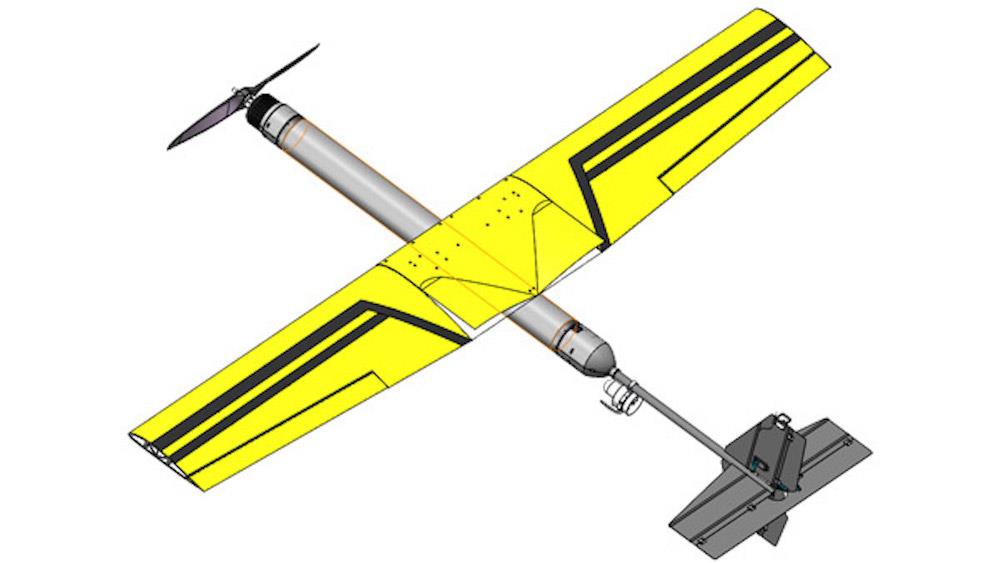(MENAFN- Asia Times) China may start developing so-called“cross-medium” weapons that are capable of traveling through different domains in one attack to bypass and defeat missile defenses.
this week, the eurasian times reported that Chinese researchers from Harbin Engineering University had unveiled two cross-medium prototype submarine drones that can both swim and fly.
The drones, named Longbow 1 and Longbow 2, can each carry a 1-kilogram payload and dive to 100 meters underwater. Longbow 1 is a fixed-wing drone while Longbow 2 features a folding wing design, the Eurasian Times report said.
Tests conducted at Longfengshan Reservoir in Wuchang in October had the flying submarine drones navigate underwater for 40 seconds, after which they surfaced and flew entirely autonomously, the same report said.
The researchers claimed to have achieved several technical solutions to allow the drones to overcome the challenges of operating in air and water, including the use of carbon fiber composites to replace metal and weight reduction measures.
They also noted that the Longbow 2's folding wing design was intended to improve cross-medium ability but presented flight stability issues, necessitating nine design modifications to achieve stable flight.
The Longbow drones are just some of the cross-medium weapons China has developed. this september, asia times reported on China's anti-ship supersonic missile-torpedo, a cross-medium weapon that can fly at Mach 2.5 for 200 kilometers, enter a sea-skimming mode for 20 kilometers, and then at the final 10 kilometers to its target shift into supercavitating torpedo mode traveling at 100 meters per second.
Its designers claim that no defense can counter such a cross-medium attack, as the weapon can change course or crash-dive up to 100 meters to evade shipboard defenses.

The Longbow 1's design. Image: Harbin Engineering University
Professor Ji Wangfeng of China's Naval Aviation University said in the Eurasian Times report that cross-medium weapons are the cheapest and most effective means of destroying a carrier battlegroup's defenses.
He and his colleagues note that the multilayered defenses of modern warships can shoot down at least half of incoming drones, planes and missiles, but a cross-medium weapon can evade these defenses by diving when detected by radar and surfacing when picked up on sonar.
Ji adds that just a handful of such weapons can confuse or even overwhelm a warship's computer. He and his team also note that a cross-medium weapon launched from 100 kilometers away has a 100% survival rate if it can fly at more than 150 kilometers per hour.
In addition to providing a new means to evade enemy air defenses, cross-medium weapons may be feasible to overcome the technical, operational and strategic limits of cruise missiles and hypersonic weapons.
Cruise missiles such as the US Tomahawk rely on substantial standoff range, nap-of-earth flight and high subsonic speed to fly below enemy radar and penetrate air defenses. Yet, despite those formidable features, multiple strategies exist to defend against cruise missile attacks.
carlo kopp notes two broad strategies to deal with cruise missile threats in Air Power Australia: denial of launch and counterforce strategy and interception of launched cruise missiles.
Kopp notes these strategies are based on the idea that cruise missile warfare functions on“use them or lose them” logic, firing off as many missiles as possible early in a conflict before defenders could destroy them on the ground and overwhelm enemy defenses.
He notes that a denial of launch or counterforce strategy requires effective targeting and strike capability. In contrast, an interception strategy needs a multilayered air defense system with land, sea and air assets.
Kopp notes that land-based surface-to-air missiles (SAM) for terminal defense are a poor option because expensive and powerful radars are required, and the systems have limited detection ranges. He notes that placing SAMs on warships increases costs but gives a mobility advantage.
Kopp mentions the need for an anti-submarine task force that includes aircraft and naval assets to defeat submarine-launched cruise missiles. However, he notes that maintaining such a task force is inherently expensive.
Against air-launched cruise missiles, Kopp mentions a two-zone scheme in which the first layer consisting of air superiority fighters and airborne warning and control systems (AWACS) shoot down enemy aircraft before they can launch their cruise missiles, with a second layer shooting down any missiles that might get through.
In recent years, hypersonic weapons have become the must-have weapons for major world powers, promising to penetrate any existing or future planned missile defense system by flying at Mach 5 or faster.
However, hypersonic weapons face feasibility and technical challenges. in a june 2022 sandboxx article , Alex Hollings argues that cost, no clear advantage over existing missiles and unclear strategic value potentially make hypersonic weapons more hype than actual military value.
Hollings notes that one round of the US Army's Long-Range Hypersonic Weapon (LRWH) costs about US$40 million per missile, or half the price of a new advanced F-35A fighter.
The author argued that hypersonic weapons don't do anything conventional missiles already do, saying that large numbers of low-cost weapons can prove just as effective as a low volume of high-cost weapons.
Hollings also says maneuvering hypersonic weapons may be slower than conventional ballistic missiles, as changing direction increases air friction and distance. In contrast, ballistic missiles fly straight to their targets.
He also argues that hypersonic weapons do not add any strategic deterrent value, noting that if existing missile defenses could not stop a full-scale missile attack involving hundreds of older ballistic missiles, then it makes no economic sense to launch the same attack using much costlier hypersonic weapons.
Apart from cost and strategic issues, hypersonic weapons also face technical problems. in a flight global article , Garrett Reim notes hypersonic weapons must overcome issues such as thermal protection, communication, positioning, navigation, maneuverability, integration, aerodynamics and a faster kill chain.
Reim notes that hypersonic missile surfaces can reach up to 2,200 degrees Celsius in flight, with the internal electronics of hypersonic weapons also generating significant amounts of heat. Hypersonic weapons require exotic materials and high-level manufacturing to prevent burning up during flight.
He also notes the formation of an external plasma layer on hypersonic weapons during flight, which can block out radar and communication signals, eliminating any option to abort missions or redirect to other targets.
Reim also mentions that conventionally-tipped hypersonic weapons require precise maneuverability and timing to know where the target is. Apart from that, he says hypersonic weapons should be able to withstand the extreme physical stresses of hypersonic flight.

An artist's red-hot rendition of Lockheed Martin's 'Common-Hypersonic Glide Body.' Credit: Flight Global.
He adds that making all missile parts fit and work together requires a systems approach to designing hypersonic weapons. In connection with this, Reim also mentions the need to fine-tune hypersonic weapon aerodynamics, which may be a lengthy and costly process.
Moreover, Reim notes that battlespace networks must be adapted for hypersonic weapons as their extreme speed requires multiple types of military equipment to share information quickly over a new battle network, raising interoperability concerns.
Cross-medium weapons will thus require novel strategies to defend against and may ultimately be more economical than hypersonic weapons to breach enemy air defenses.






















Comments
No comment